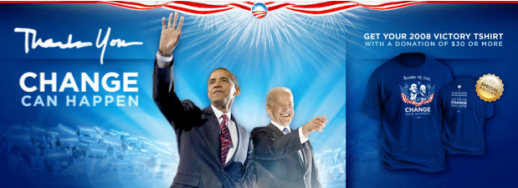It’s no secret that much of President Barack Obama’s campaign for getting elected “the leader of the free world” had a lot to do with reaching out to the denizens of cyberspace in ways no other candidate, including his opponent, John McCain, ever has. While Al Gore may have (erroneously) “invented the Internet”, Obama, and his Net-savvy campaign handlers, and a vast amount of volunteers, used online marketing techniques to virally/successfully get their word out. “Obama built an incredible national infrastructure by combining the Internet and his field operations,” said Nicco Mele, of Harvard Kennedy Business School, who conducted a study of Obama’s marketing methods.
That’s right, Obama was marketed to the people of the United States, and we internet marketers (in the commercial profit and non-profit realms) can learn a lot from what was done. Because it is a success story, as noted in many publications from The Denver Post to Time Magazine.
Here are some of the methods the Obama online strategists used:
1. They made online donations easy. The campaign drew most of its campaign contributions from online donors, and made it easy with just one click! It didn’t matter… $1.00 or $100.00. They accepted anything and made it very easy to do so. They made it quick, cheap, and far less intimidating, than writing a check, for political novices. Usability and comfort were the keys.
2. They used Facebook. Many groups, regional and national, were created using the social networking site Facebook. For example: When there was a backlash, over Obama’s middle name, a campaign over Facebook motivated many supporters to change their middle names to “Hussein.” Over night, what was once a social stigma became acceptable. This sort of viral campaigning was creative and politically provocative – no matter what people felt about the name, attention was drawn (marketing 101).
3. They utilized new social networking. Facebook, Myspace, and other social networking sites were not the only places Obama targeted. New sites were created, such as “One Million Strong”. In less than a month, it drew in 295,000 members. Cheryl Contee, of Issue Dynamics Inc., a public relations firm that focuses on online trends, said Obama had “far and away the most momentum on social network sites.” And that “his popularity [is] among younger, well-educated people, ages 18 to 35.”
4. Video-game imbedding. Obama was the first presidential candidate to strategically imbed ads within video games. Understanding the vast popularity of video games, with those over 18 (the new voters), Obama took advantage of this viral marketing method.
5. Internet ads. Obama used the “you have to spend money to make money” model of advertising that all marketers know is a cardinal truth. With the influx of donations, the “extra” money was used to buy time and space all across the Internet.
6. YouTube. The site hosts free videos and Obama jumped on that channel. An estimated 13 million people watched Obama spots on the site.
7. Loyalty. One thing is for sure… Obama’s supporters were loyal, to his cause and promise, for change in the nation. Loyal online supporters brought in more supports by blogging, linking, and recommending various social networks, and donor sites. Brands know that customer loyalty in an important part of marketing. That holds true for politics as well.
8. Bloggers. Never underestimate the power of the Blog. The Blog can make or break a career. It can fine tune and pinpoint facts that major news outlets overlook.
9. Micro-Blogging. Obama himself was a fan of Twitter. Many people followed him on Twitter. By using this popular Micro-Blog, Obama created loyalty from those who felt something in common with the candidate. Lifestyle/affinity marketing was used effectively.
10. Quick response. When McCain’s campaign criticized, or accused Obama, the Obama campaign was able to respond via Internet ads, sometimes within minutes. A method much quicker than traditional television and print responses. The speed of technology was used effectively.
The top three factors non-profits can learn from Obama’s successful online marketing campaign:
• Recruitment
• Loyalty
• Fund raising
There is much a non-profit organization can learn from Obama’s success. Recruitment online was done through Blogging, social network groups, streaming video, and creative ad placement. The social groups empowered loyalty, using a positive message, to the masses, that encouraged members to recruit more members. The Obama campaign made fund-raising easy, comfortable, and quick. While making donors feel they were contributing to something greater than themselves.
(Related articles: Look no further about how to download kodi on firestick. Read the blog post here to learn everything on one platform)

